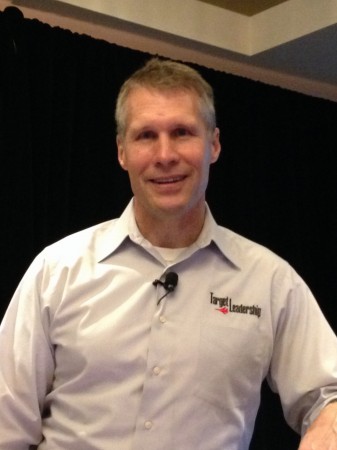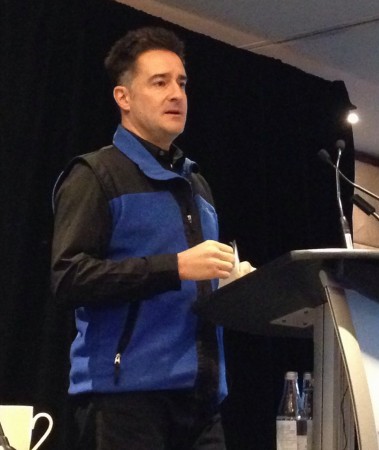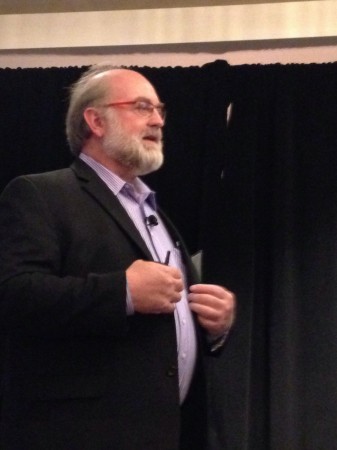Personal responsibilty of leadership
The concept of leadership is usually perceived as having sway over the actions of others, but at their annual convention, Ontario Trucking Association members were told that being a good leader comes down to personal decisions and actions.
The first speaker of the day was Jeff “Odie” Espenship, a former fighter pilot in the United States Air Force, a commercial pilot and a motivational speaker. Espenship spoke of personal tragedy—the death of his brother and a close friend in an vintage airplane crash—and of a military aircraft crash that took a number of lives, to remind the crowd that while it’s easy to point the finger of blame at others, leaders should be turning that finger inward. Leaders, and all people in fact, have the opportunity to influence the behaviour of others, which means it is up to those in positions of power and authority to create a culture that promotes planning, safety, and following the rules.
Espenship said it is human nature, for smart people to do dumb things, even when they know better, and sometimes especially when they know better.
“We have all gone out there in our lives and done something dumb and dangerous and different, and we have gotten away with it,” he said, adding that getting away with it has a tendency to teach people situational compliance.

“We will comply with all those policies and rules they throw at us. We know what they are. We will comply with them until the situation dictates something else, then we rationalize it in our minds. Sometimes we think about it. Sometimes it is a snap decision. We all have good intentions. We all want to get it done, that’s who we are. We will go ahead and get the job completed and for the most part we will get away with it. Right up until we don’t.”
Epsenship noted that it is a well-known fact in military circles that at approximately 300 hours of flying time, the accident rates for fighter pilots starts to jump because it’s at that point they start to feel confident enough that things are routine, but they haven’t been around long enough to see the bad consequences of situational compliance gone wrong. It’s at that point where they think they can try to push the boundaries a bit, usually with the idea that “I’ll be careful” somewhere in the back of their minds.
“Have you ever heard anybody say that? ‘I’ll be careful on the job.’ That’s one of those leading indicator phrases you need to watch out for.”
He also emphasized that there are typically two types of cultures in any organization, the official work culture that includes the official rules and regulations and the job culture—the way things normally get done and the way people normally operate. Espenship believes that leaders are responsible in setting the tone for both. He cited the example of a B-52 which crashed killing the pilot, Arthur “Bud” Holland and three crew members. Espenship said Holland had a history of pushing the B-52 well past its operational limits and was in the process of doing it once again when he lost control of the plane. While is behaviour was well outside the scope of the work culture—rules and regulations said the plane shouldn’t be flown in such a manner—the job culture was one where Holland pushed the limits all the time, took unnecessary risks, and that nobody in his squadron called him on his actions.
“Leaders create and maintain the culture of their organization. And their fighter pilots will operate in the norms of that culture that’s created. So when you and I get up every single day, we have some questions to ask ourselves: Who are your Bud Hollands?” Who are they? Do you have a name that’s rattling around in your head? If something were to happen, and somebody said, ‘guess who it was,’ you’d say that name.
“You need to approach that individual, talk to them. A lot of times they just are incorrigible. Maybe you need to retrain them. Maybe they need to be retired. Maybe they need to be fired.”
He added that while businesses may not have any Bud Hollands on staff, they may have a rule or a procedure that has a similar effect on the work culture, and those things need to be addressed as well.
Brian Scudamore, the founder and CEO of Vancouver-based 1-800-Got-Junk also spoke of the importance of looking inward to develop as a leader. Whereas Espenship places a value on following rules, Scudamore takes the opposite approach.
“I’m not a fan of rules,” he said. “I can imagine in the trucking world where safety is paramount there are lots of rules. But how do you think beyond the rules? How can you still be safe? How can you still grow your business but do things differently?”

Scudamore suggested taking a three-pronged approach. He visualizes a triangle with each point represented by a different concept: vision, people and systems, and he believes that each success he has experienced is built on those three points.
When it comes to people, Scudamore said that as a leader it took him a long time to learn how to surround himself with the right people.
“My first big people lesson was learning that I had the wrong people.” He said at one point early in his career, he had a small staff (11 people) and most of them were “bad apples”. He started to avoid communicating with his staff and he stopped enjoying his work because of the staffing situation. To resolve the situation he did a group firing where he took the blame for the situation on himself.
“I said, ‘guys, I let you down here. I was your leader. I was the guy that recruited you and trained you. I’ve lost faith. It’s not working. Maybe I hired the wrong people. Maybe I just didn’t train you and give you the love and the attention, but it is not working and we are cutting ties here.’ And off they went. I think they respected that I took accountability because it was my fault and nobody else’s but I learned that day that my company from that day forward would be all about people.”
He added that after that experience, “I was slow to hire and quick to fire, and if I found I had the wrong person I wasn’t going to let it built up to 9 or 11 wrong people. I’d get them out quickly. I built this culture where it was all about having fun together, not only could we do something great with this junk removal company, we could have a good time doing it.”
For Scudamore, it wasn’t enough to have the right people in place; he needed a vision of his company’s future, so he compiled a list of all of his goals and expectations for the company, including expanding into 30 bigger markets, and getting featured on Oprah Winfrey’s TV show. He admits that many of his goals seemed unattainable, but that because an advantage—he only hired (or continued to employ) those people who could share his vision, who could cheerlead the company or could come up with ways of turning those goals into reality.
“I created a picture taking myself as the leader, the entrepreneur, taking the vision from my head and putting it into writing and making it so clear that all my employees and team, family and friends could latch onto what the picture was and either help support it or get out of the way,” he said.
“Do you have a vision for your company? I would bet the answer is ‘no’ only because most people I talk to say ‘I don’t know what a vision is, I don’t know how create it, I certainly don’t know how to get people aligned on power of a vision.’ If you have a vision it is awesome, if you don’t have one, think for ten minutes and write down on one page what the future of your business looks like and why the business matters. I’m sure it doesn’t matter just because you want to make money. People want to grow, but when you dig in there are a lot of reasons why people want to build a business. If you can tap into that something special and people can read that vision, you’ll be amazed at the power of it.”
As for the systems aspect of 1-800-Got-Junk, Scudamore said he built his business with the franchising model in mind. He likes the repeatability of best practices and systems that come with franchises and thought it would be smart to employ those techniques right from the start. He also attributed much of his success to communications—both internal and external. Externally, Scudamore and his team actively and regularly promote his company through the media. He said with every piece that ran in newspapers and magazines or on TV, the number of customer calls skyrocketed. Internally, Scudamore suggests learning how to listen to employees is the key to improving the company.
“We ask people ‘how do we make the business better?’ If you want to take an industry you feel that needs reinvention, who best to ask? Ask your people. Ask them to figure it out. They are the ones with the great ideas. If you can listen and learn the future possibilities are endless.”
Another of the day’s speaker’s Thomas Frey, a futurist and the director of the DaVinci Institute in Louisville, Colorado, emphasized how much power leaders have to shape the future, assuming they understand their power to do so.

“We’re a very backward looking society. We’re backward looking because it’s just human nature. We’ve all personally experienced the past. As we look around us, we see evidence of the past all around us. All the information we come into contact with is essentially history. So the past is very knowable, and yet we are going to be spending the rest of our lives in the future. It is almost as if we are walking backwards into the future,” he said.
“The future gets created in the minds of everybody around us. We all participate in creating the future, but some people have more impact. They have more influence over how the future evolves. People make decisions today based on their understanding of what the future holds. The future creates the present. This is just the opposite of what most people think. Most people think that what we are doing today is going to somehow create the future. But from a little different perspective, it’s these images we have in our heads of what the future holds that determine our actions today. So if we change people’s vision of the future, we change the way they make decisions today.”
As to what he expects to see in the coming years that will affect the transportation industry, Frey said the pervasive use of sensors embedded into everything will change the way we track, monitor and order all types of goods, not to mention monitor drivers’ health.
“We are creating a digital layer of infrastructure over the physical world. A lot of it is happening through the Internet of Things.”
He also said with the growing adoption of 3D printing, what we will be shipping will change drastically. People will be printing everything from food to clothing to housing on site.
“Products made locally will reduce the need for shipping. What it does is shift things so we are shipping raw material not finished product.”
Frey also brought up the topic of autonomous vehicles—both land-based cars and trucks and aerial drones. He said they will be significantly safer, reduce the need for drivers, result in lower fuel bills, lower accident rates, and reduce insurance costs.
Have your say
This is a moderated forum. Comments will no longer be published unless they are accompanied by a first and last name and a verifiable email address. (Today's Trucking will not publish or share the email address.) Profane language and content deemed to be libelous, racist, or threatening in nature will not be published under any circumstances.